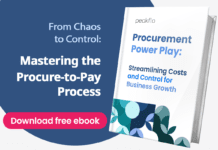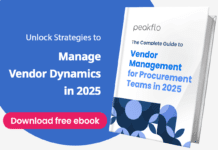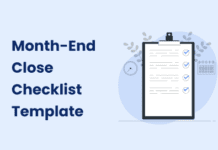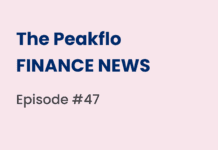In today’s fast-paced business environment, the accuracy and consistency of financial records are crucial for accountants, bookkeepers, auditors, and finance team members.
The bank reconciliation process is one essential practice that safeguards the integrity of these records. It ensures that bank statements match the company’s accounting records.
This article will provide a bank reconciliation example and delve into bank reconciliation best practices to efficiently and effectively perform this critical task.
Whether you are a seasoned professional or a newcomer in the world of finance, this comprehensive guide will serve as a valuable resource to help you navigate this process smoothly.
What Is a Bank Reconciliation?
Bank reconciliation is the process of comparing and matching the account balance reported by the bank with the general ledger of a business. This is done through a bank reconciliation statement, allowing businesses to identify and rectify discrepancies or potential errors.
Businesses maintain a cash book to record both bank transactions and cash transactions. The cash book is divided into two columns – the cash column, which shows the available cash, and the bank column, which displays the cash at the bank.
By diligently recording all transactions, businesses can keep track of their financial activities and ensure the accuracy of their records.
Banks also keep accounts for every customer, recording deposits on the credit side and withdrawals on the debit side. At regular intervals, usually monthly, banks send account statements to their customers. These statements provide a detailed summary of all the transactions during that period.
Let’s walk through a simplified example of a bank reconciliation:
Company XYZ identifies a deposit of $1,000 made on the last day of the month that hasn’t yet appeared on the bank statement. A check for $500 was issued by the company but not yet cashed.
Company XYZ compares any bank fees or interest charges on the bank statement with its records. A $10 bank fee for account maintenance. A bank error that resulted in a $50 overcharge on a transaction.
After accounting for the additions and deductions, Company XYZ adjusts its bank balance accordingly.
Starting Bank Balance: $10,000
Deposits in Transit: +$1,000
Outstanding Checks: -$500
Bank Fee: -$10
Bank Error: -$50
Adjusted Bank Balance: $10,000 + $1,000 – $500 – $10 – $50 = $10,440
The adjusted bank balance now matches the ending cash balance in the general ledger.
Common Discrepancies in Bank Reconciliation
In the process of bank reconciliation, discrepancies may arise due to various reasons. It’s essential to identify and address these differences to maintain accurate financial records. Here are common discrepancies:
- Checks that have been written but not yet entered into the company’s accounting system.
- Mistakes in bookkeeping, either by the company or errors made by the bank itself.
- Deposits made to the account but not yet processed or cleared by the bank.
- Bank charges or interest applied by the bank but not yet recorded in the company’s accounting system.
- Unauthorized withdrawals or transactions resulting from fraudulent activities.
Regular bank reconciliation, ideally monthly, is crucial for financial accuracy. Weekly checks can be too time-consuming while delaying increases the risk of overlooked mistakes impacting cash flow. Finding a balance based on transaction volume is key. Many opt for reconciliation before credit control meetings, ensuring up-to-date data. This approach considers bank statement balances, reconciliation statements, and factors like service fees. Some businesses choose professional help to handle the complexity, ensuring accurate financial positions without the burden of in-house reconciliation. Regular, timely reconciliation is vital for a clear understanding of the company’s financial health.
Types of Bank Reconciliation
Bank reconciliation is a process that helps individuals and businesses ensure that their bank records match the transactions recorded in their accounting system. There are different types of bank reconciliations, depending on the purpose and the nature of the transactions. Here are some common types:
Internal Reconciliation
Internal reconciliation typically refers to the process of reconciling transactions and accounts within an organization’s internal systems. In the context of banking, internal reconciliation could involve reconciling transactions recorded in the company’s accounting software with those in its internal financial records.
External Reconciliation
External reconciliation usually involves comparing an organization’s financial records with external statements or documents, such as bank statements or vendor invoices. In the context of banking, external reconciliation would involve comparing the company’s internal records of transactions with the bank statement to ensure they match.
Aggregate Reconciliation
Aggregate reconciliation is a financial process that involves consolidating data from multiple accounts, sources, or entities and then reconciling them against a unified set of records or documents. By aggregating data from various accounts, the reconciliation process aims to verify the accuracy of financial statements and the requirements of regulatory compliance.
Steps to Do Bank Reconciliation
Bank reconciliation helps you verify business accounting numbers. Here are the steps to follow:
1. Obtain Bank Records
If you’d like to initiate the bank reconciliation process, the first step is to obtain your bank records. You can source these records from a variety of channels, like online banking portals, or directly from your accounting software if it integrates with your bank.
In case your business operates with multiple accounts such as checking and credit card accounts, make sure to gather statements for each account separately. After obtaining the necessary records, review each statement thoroughly.
Pay attention to itemized cash and other deposits made into your checking account. This will help you avoid common mistakes made during the bank reconciliation process.
2. Compile Business Records
Begin by opening your ledger, which records your business’s income and outgoings. The ledger may be in various formats, such as a logbook, spreadsheet, or within an accounting software package.
If you use automation software integrated into your accounting system, such as Peakflo, take advantage of automation features to streamline your record-keeping process. This technology automatically imports bills and receipts, organizes data, and saves time while reducing errors, helping to maintain accurate financial records.
3. Adjust Your Bank Statements
The process of adjusting your bank statements involves:
- Account for missing deposits: Ensure that each deposit appearing on your bank statement is accurately recorded as income in your accounts. If you find any missing deposits, enter them and identify whether they resulted from a sale, interest, a refund, or another source.
- Deduct outstanding checks: Outstanding checks are checks that have been written and recorded in the business’s cash account but have not yet cleared the bank account. These often occur when checks are written near the end of the month.
- Solve bank errors: Identify and correct any mistakes made by the bank when preparing the bank statement. Adjust your records accordingly to ensure your financial data is accurate.
4. Adjust the Cash Balance
There are a couple of steps to adjust your cash balance:
- Verify receipts: Review your bank statement to identify any missing transactions, such as payments received but not recorded in your ledger. Ensure that each deposit (from sales, interest, or refunds) is recorded separately, even if made on the same day, and enter any missing transactions.
- Review payments: Examine the bank withdrawals recorded in your books, including bank fees and other charges.
Account for discrepancies between your ledger and bank statement, such as overdraft fees, service charges, or payments made via cash or from another account. Deduct these from your ledger to ensure each entry matches a withdrawal in your bank statement. - Account for Bank Charges, NSF Checks, and Errors: Add interest or deposits received, correct calculation, typing, or omission errors, and deduct NSF checks. Also, account for un-presented and un-credited checks by adding and subtracting them, respectively.
5. Compare the Balances in the Ledger
After adjusting the bank statement and ledger, the amounts should match, signifying accurate financial records. If discrepancies exist, investigate if they stem from a different period by reviewing past reconciliation reports or financial records.
For small discrepancies, adjust balances and record differences in your books to maintain consistency and accuracy. When adjusted balances match, prepare journal entries for the reconciled balance, noting that outstanding checks are already in the ledger and don’t need recording.
Importance of Bank Reconciliation
Bank reconciliation is a crucial financial practice for individuals and businesses alike. Here are some reasons why it’s important:
- Ensures accuracy by comparing accounting records with bank statements.
- Helps detect unauthorized transactions and fraudulent activities.
- Aids effective cash flow tracking and management.
- Supports informed financial decisions, budgeting, and goal-setting.
- Essential for regulatory compliance and meeting reporting requirements.
- Fundamental for maintaining financial system integrity and transparency.
- Influences creditworthiness by providing reliable financial statements.
- Avoids penalties and disruptions by ensuring awareness of actual cash balance.
- Provides a clear audit trail for financial transparency and accountability.
The Easiest Way to Do Bank Reconciliation is to Automate It.
We all know how frustrating bank reconciliation is. Manual processes are always riddled with errors, such as double entries, data discrepancies, or unknown transactions.
Solving the mistake involves not just one, but four to five steps. Sorting through invoices, receipts, emails, and entries is frustrating as it is challenging.
Let Peakflo do the account transactions for you. Our AP software syncs the data from Peakflo to your accounting software, or the other way around, on a daily basis. You won’t need to worry about closing books at the month-end, it’ll be done before you realize it.
Reconcile seamlessly with Peakflo, starting from today.









![Why AI Sales Calls Are Making Good Sales Reps Even Better [2025 Guide] ai sales calls](https://cdn-kmjmp.nitrocdn.com/YvtqmrsiHUxqerlSiZgbfzqqTARWTElr/assets/images/optimized/rev-834053b/blog.peakflo.co/wp-content/uploads/2025/09/65168cf6-3001-4733-8cbc-12d5684cf449-218x150.webp)

































